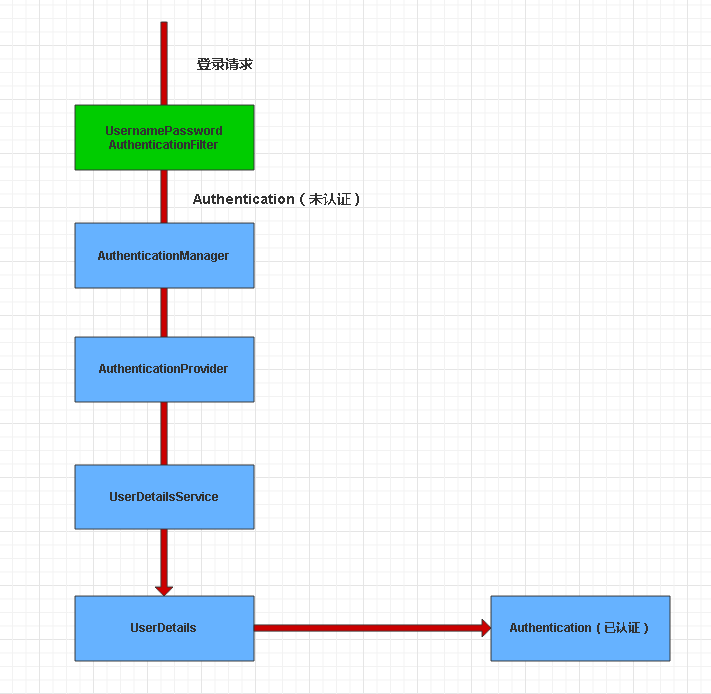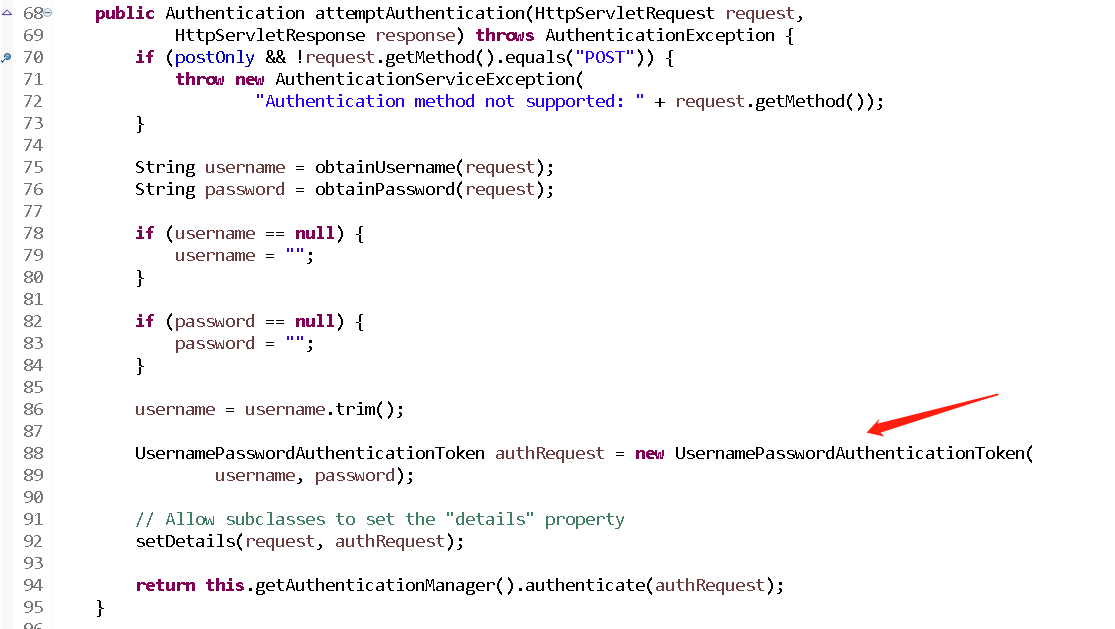1.认证流程流程
通过断点调试,可以看到在UsernamepasswordAuthenticationFilter中构造了一个
UsernamePasswordAuthenticationToken对象

打开UsernamePasswordAuthenticationToken可得知,该实现类是Authentication的子类,因为Authentication是封装了用户的信息。
在该构造函数中,其中super(null)是调用了父类的方法
,
父类的方法如下:
public AbstractAuthenticationToken(Collection<? extends GrantedAuthority> authorities) {
if (authorities == null) { //为空时,需要赋个默认的权限,因为此时还未进行身份认证
this.authorities = AuthorityUtils.NO_AUTHORITIES;
return;
}
for (GrantedAuthority a : authorities) {
if (a == null) {
throw new IllegalArgumentException(
"Authorities collection cannot contain any null elements");
}
}
ArrayList<GrantedAuthority> temp = new ArrayList<GrantedAuthority>(
authorities.size());
temp.addAll(authorities);
this.authorities = Collections.unmodifiableList(temp);
}setAuthenticated(false) 代表当前存进去的principal/credentials是否经过身份认证,此时肯定是没有的。
setDetails(request, authRequest);该方法会把请求的一些信息设置到UsernamePasswordAuthenticationToken里面去,包括当前发起请求的IP,Session等
return this.getAuthenticationManager().authenticate(authRequest); //往AuthenticationManager靠拢AuthenticationManager该类本身不包含校验的逻辑,它的作用是用来管理AuthenticationProvider。
该方法会请求进入:ProviderManager.authenticate()方法,该类实现了AuthenticationManager接口
public Authentication authenticate(Authentication authentication)
throws AuthenticationException {
Class<? extends Authentication> toTest = authentication.getClass();
AuthenticationException lastException = null;
Authentication result = null;
boolean debug = logger.isDebugEnabled();
for (AuthenticationProvider provider : getProviders()) { //
if (!provider.supports(toTest)) {
continue;
}
/*
getProviders() 拿到所有的AuthenticationProvider,校验逻辑都是在Provider中
因为不同的登录方式,它的认证逻辑是不通 的,目前使用的用户名+密码的方式,后续还会有第三方登录,手机 号验证码登录等,provider.supports(toTest)是否支持当前的登录方式(判断)
对于用户名密码方式,它传递的token是:UsernamePasswordAuthenticationToken,而对于第三方登录时的验证方式则是SocialAuthenticationToken
*/
if (debug) {
logger.debug("Authentication attempt using "
+ provider.getClass().getName());
}
try {
//具体执行校验逻辑
result = provider.authenticate(authentication);
if (result != null) {
copyDetails(authentication, result);
break;
}
}
catch (AccountStatusException e) {
prepareException(e, authentication);
throw e;
}
catch (InternalAuthenticationServiceException e) {
prepareException(e, authentication);
throw e;
}
catch (AuthenticationException e) {
lastException = e;
}
}
if (result == null && parent != null) {
// Allow the parent to try.
try {
result = parent.authenticate(authentication);
}
catch (ProviderNotFoundException e) {
}
catch (AuthenticationException e) {
lastException = e;
}
}
if (result != null) {
if (eraseCredentialsAfterAuthentication
&& (result instanceof CredentialsContainer)) {
((CredentialsContainer) result).eraseCredentials();
}
eventPublisher.publishAuthenticationSuccess(result);
return result;
}
if (lastException == null) {
lastException = new ProviderNotFoundException(messages.getMessage(
"ProviderManager.providerNotFound",
new Object[] { toTest.getName() },
"No AuthenticationProvider found for {0}"));
}
prepareException(lastException, authentication);
throw lastException;
}provider.authenticate()实现类是写在AuthenticationProvider的实现类AbstractUserDetailsAuthenticationProvider中
public Authentication authenticate(Authentication authentication)
throws AuthenticationException {
Assert.isInstanceOf(UsernamePasswordAuthenticationToken.class, authentication,
messages.getMessage(
"AbstractUserDetailsAuthenticationProvider.onlySupports",
"Only UsernamePasswordAuthenticationToken is supported"));
String username = (authentication.getPrincipal() == null) ? "NONE_PROVIDED"
: authentication.getName();
boolean cacheWasUsed = true;
UserDetails user = this.userCache.getUserFromCache(username);
if (user == null) {
cacheWasUsed = false;
try {
//获取用户信息,具体实现类在:DaoAuthenticationProvider.retrieveUser()
user = retrieveUser(username,
(UsernamePasswordAuthenticationToken) authentication);
}
catch (UsernameNotFoundException notFound) {
logger.debug("User '" + username + "' not found");
if (hideUserNotFoundExceptions) {
throw new BadCredentialsException(messages.getMessage(
"AbstractUserDetailsAuthenticationProvider.badCredentials",
"Bad credentials"));
}
else {
throw notFound;
}
}
Assert.notNull(user,
"retrieveUser returned null - a violation of the interface contract");
}
try {
preAuthenticationChecks.check(user);
additionalAuthenticationChecks(user,
(UsernamePasswordAuthenticationToken) authentication);
}
catch (AuthenticationException exception) {
if (cacheWasUsed) {
cacheWasUsed = false;
user = retrieveUser(username,
(UsernamePasswordAuthenticationToken) authentication);
preAuthenticationChecks.check(user);
additionalAuthenticationChecks(user,
(UsernamePasswordAuthenticationToken) authentication);
}
else {
throw exception;
}
}
postAuthenticationChecks.check(user);
if (!cacheWasUsed) {
this.userCache.putUserInCache(user);
}
Object principalToReturn = user;
if (forcePrincipalAsString) {
principalToReturn = user.getUsername();
}
return createSuccessAuthentication(principalToReturn, authentication, user);
} protected final UserDetails retrieveUser(String username,
UsernamePasswordAuthenticationToken authentication)
throws AuthenticationException {
UserDetails loadedUser;
try {
loadedUser = this.getUserDetailsService().loadUserByUsername(username);
/**
getUserDetailService在调用我们提供的UserDetailService的实现,也就是:MyUserDetailsService
*/
}
catch (UsernameNotFoundException notFound) {
if (authentication.getCredentials() != null) {
String presentedPassword = authentication.getCredentials().toString();
passwordEncoder.isPasswordValid(userNotFoundEncodedPassword,
presentedPassword, null);
}
throw notFound;
}
catch (Exception repositoryProblem) {
throw new InternalAuthenticationServiceException(
repositoryProblem.getMessage(), repositoryProblem);
}
if (loadedUser == null) {
throw new InternalAuthenticationServiceException(
"UserDetailsService returned null, which is an interface contract violation");
}
return loadedUser;
}拿到用户信息之后,回到AbstractUserDetailsAuthenticationProvider
try {
preAuthenticationChecks.check(user);
additionalAuthenticationChecks(user,
(UsernamePasswordAuthenticationToken) authentication);
//在dao里校验密码是否匹配
}它会预检查用户是否过期,是否禁用,之后检查密码是否匹配。
预检查之后还会有后置检查
postAuthenticationChecks.check(user); //所有检查都通过,就会认为用户的认证是成功的。
return createSuccessAuthentication(principalToReturn, authentication, user);
protected Authentication createSuccessAuthentication(Object principal,
Authentication authentication, UserDetails user) {
UsernamePasswordAuthenticationToken result = new UsernamePasswordAuthenticationToken(
principal, authentication.getCredentials(),
authoritiesMapper.mapAuthorities(user.getAuthorities()));
result.setDetails(authentication.getDetails());
return result;
}再次new 了UsernamePasswordAuthenticationToken对象,区别再与构造方法不同,传递的参数不同,这个时候权限,用户信息都已经拿到
2.认证结果如何在多个请求之间共享
3.获取用户认证的信息